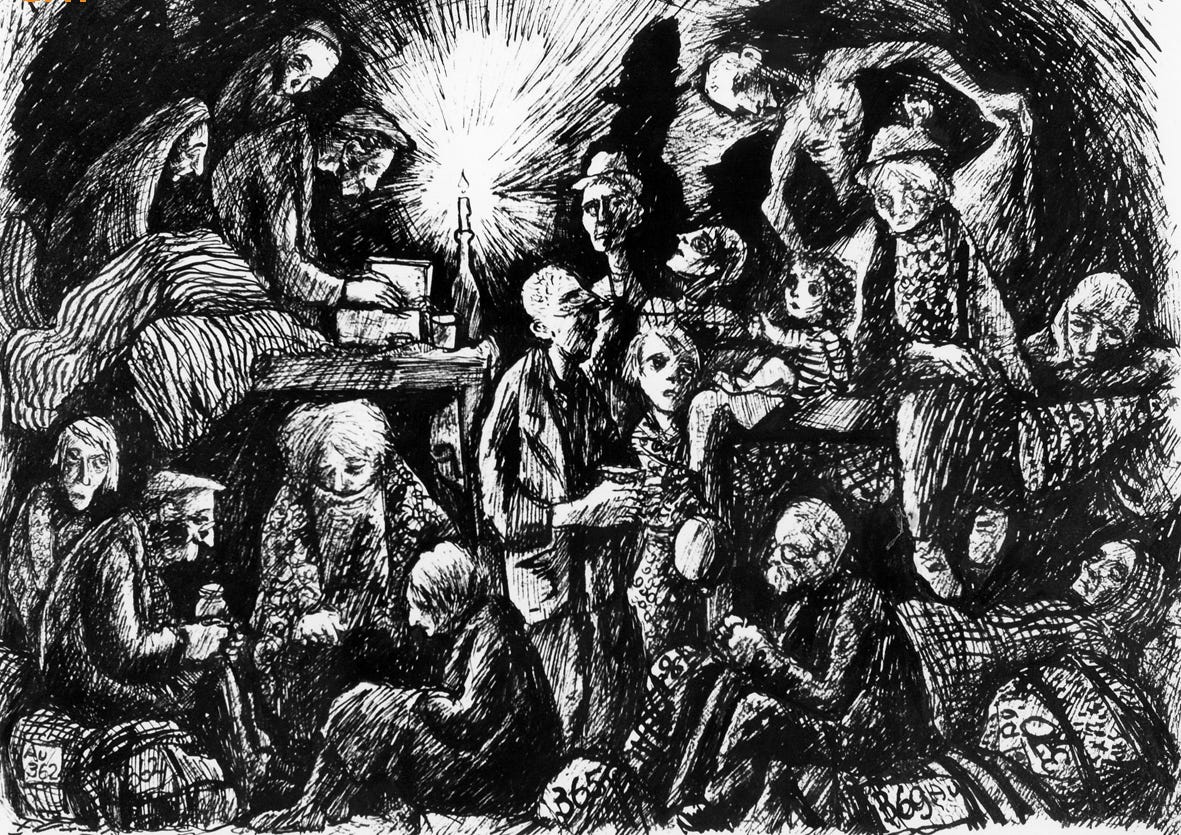"Culture in the anteroom to hell."
Ghetto Central Library at Theresienstadt Camp - near Prague
Theresienstadt, a transit camp for Jews on their way to death camps, was a Potemkin Village
Theresienstadt is the German name for the Czech fortress town of Terezín, located about 25 miles from Prague. In 1941 the Nazis decided that Terezín, surrounded by walls and a moat, was ideal for a Jewish ghetto. The first transport of Jews from Prague arrived November 1941, and by June 1942 the Czech population was relocated and the entire town used to imprison Jews.
Theresienstadt was a transit camp for Jews on their way to death camps, mainly Auschwitz and Treblinka, and its appalling conditions were such that death from disease and deprivation were constant and substantial.1
In February 1944, the Schutzstaffel (SS)2 embarked on a "beautification" campaign at Theresienstadt to prepare it for a Red Cross visit. Streets were renamed and cleaned; sham shops and a school were set up; the SS forced prisoners to perform cultural activities.
On 23 June 1944, the Red Cross visitors were led on a tour through this "Potemkin village"— they did not notice anything amiss.3 Elaborate measures were taken to disguise conditions in the ghetto and to portray an atmosphere of normalcy.4
Ghetto Central Library
The Ghetto Central Library (Ghettozentralbücherei) opened in Theresienstadt in November 1942 and contained 60,000 books and 15 full-time librarians by the end of 1943. Philosopher, Emil Utitz, was appointed head librarian.5
The library grew, in part, because Jews entering Theresienstadt packed a treasured book instead of food, clothing, an extra pair of shoes, or a blanket in their severely restricted luggage allotment. Most of these books ended up in the library. 6
Other books came from camp prisoners themselves. Leaving their entire lives and worldly possessions behind, each incoming prisoner could only bring fifty kilograms of personal belongings with them. Prisoner, Jana Friesová, wrote7:
“Everyone chose [the book] that . . . was closest to his or her heart.”
The library represented an organized system of life, all the more inspirational and strengthening as it thrived, providing links to the past as well as room to hope for a future within the much larger system of death.8
Emil Utitz, Librarian
Emil Utitz, Czech philosopher and psychologist of Jewish descent was appointed librarian. After liberation he wrote “The central ghetto library in the concentration camp Terezín.” 9
Utitz viewed the concentration camp as a non-human world, in which one is denied the possibility of starting a new chain of action and reasonably predicting its consequences. In such circumstances, how can one remain fully human? The answers he offered linked imagination, fiction and reality.10
Fortress of Lies -Liberated May 8, 1945
Gritten, Ricke Elaine Ballard. Holocaust Remembrance Day: Theresienstadt Ghetto Central Library. January 19, 2019.
Allen, Michael Thad (2002). The Business of Genocide: The SS, Slave Labor, and the Concentration Camps. Chapel Hill, NC: University of North Carolina Press.
Adler, H. G. (2017) [1955]. Theresienstadt 1941–1945: The Face of a Coerced Community. Translated by Cooper, Belinda. Cambridge: Cambridge University Press; Steinacher, Gerald (2017). Humanitarians at War: The Red Cross in the Shadow of the Holocaust. Oxford University Press.
Theresienstadt: Red Cross Visit. Holocaust Encyclopedia. United States Holocaust Memorial Museum.
Intrator, Miriam. “‘People Were Literally Starving for Any Kind of Reading’: The Theresienstadt Ghetto Central Library, 1942-1945.” Library trends 55.3 (2007): 513–522. Also,
Miriam Intrator. “Avenues of Intellectual Resistance in the Ghetto Theresienstadt: Escape Through the Ghetto Central Library, Reading, Storytelling and Lecturing. “A Master’s paper for the M.S. in L.S. degree. April, 2003. Advisor: David Carr.
Frýd, N. (1965). Culture in the anteroom to hell. In František Ehrmann (Ed.), Terezín (pp. 206–17). Prague: Council of Jewish Communities in the Czech Lands; Friesová, J. R. (2002). Fortress of my youth: Memoir of a Terezín survivor (E. Morrisby and L. Rosendorf, Trans.). Madison: University of Wisconsin Press.
Intrator, Miriam. “‘People Were Literally Starving for Any Kind of Reading’: The Theresienstadt Ghetto Central Library, 1942-1945.” Library trends 55.3 (2007): 513–522.
Utitz, E. (1965). The central ghetto library in the concentration camp Terezín. In František Ehrmann (Ed.), Terezín (pp. 263–266). Prague: Council of Jewish Communities in the Czech Lands.
Tereza Matějčková, “How Emil Utitz salvaged his humanity in a non-human world.” Psyche. November 30, 2020.






This is such a moving example of people’s attempt to preserve their humanity in the face of unspeakable evil. At the Pinkhas Synagogue in Prague’s Jewish Quarter, there is an exhibition of drawings done by children who had been imprisoned at Terezín. There, too, you can see how desperately people tried to preserve a vestige of normal life in the midst of such suffering.
A bittersweet legacy of an utterly ghastly time.